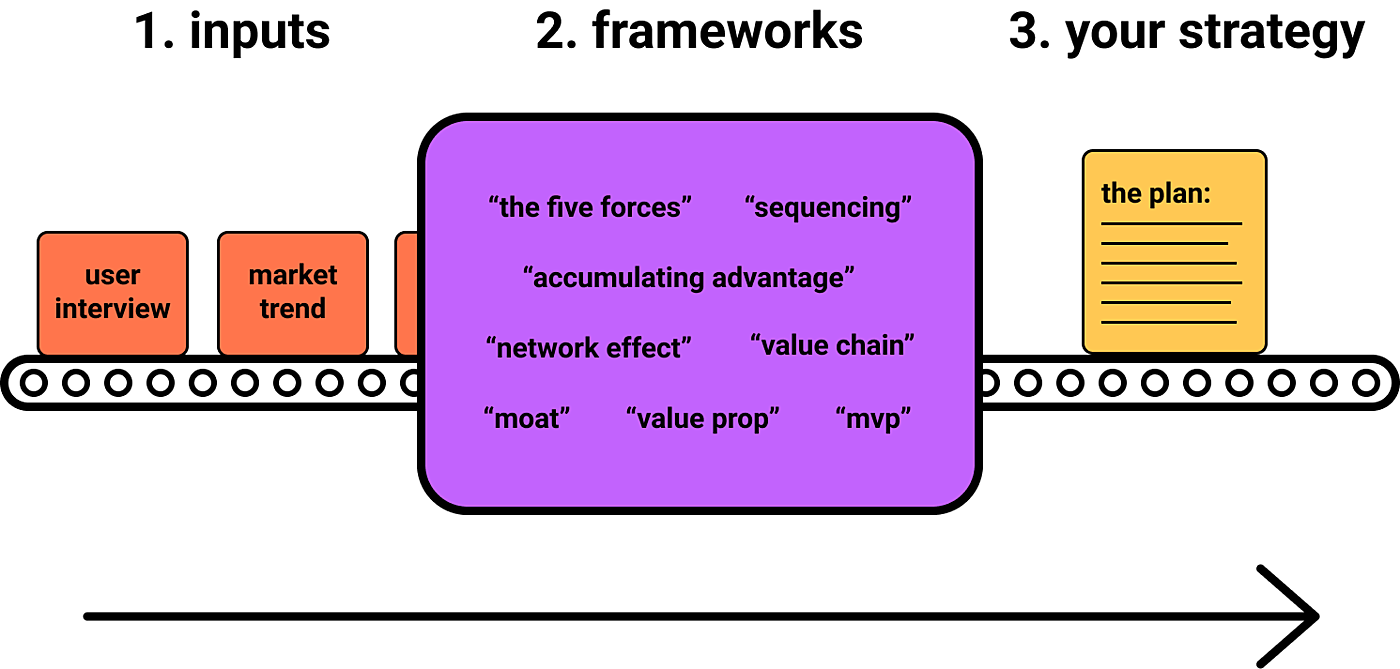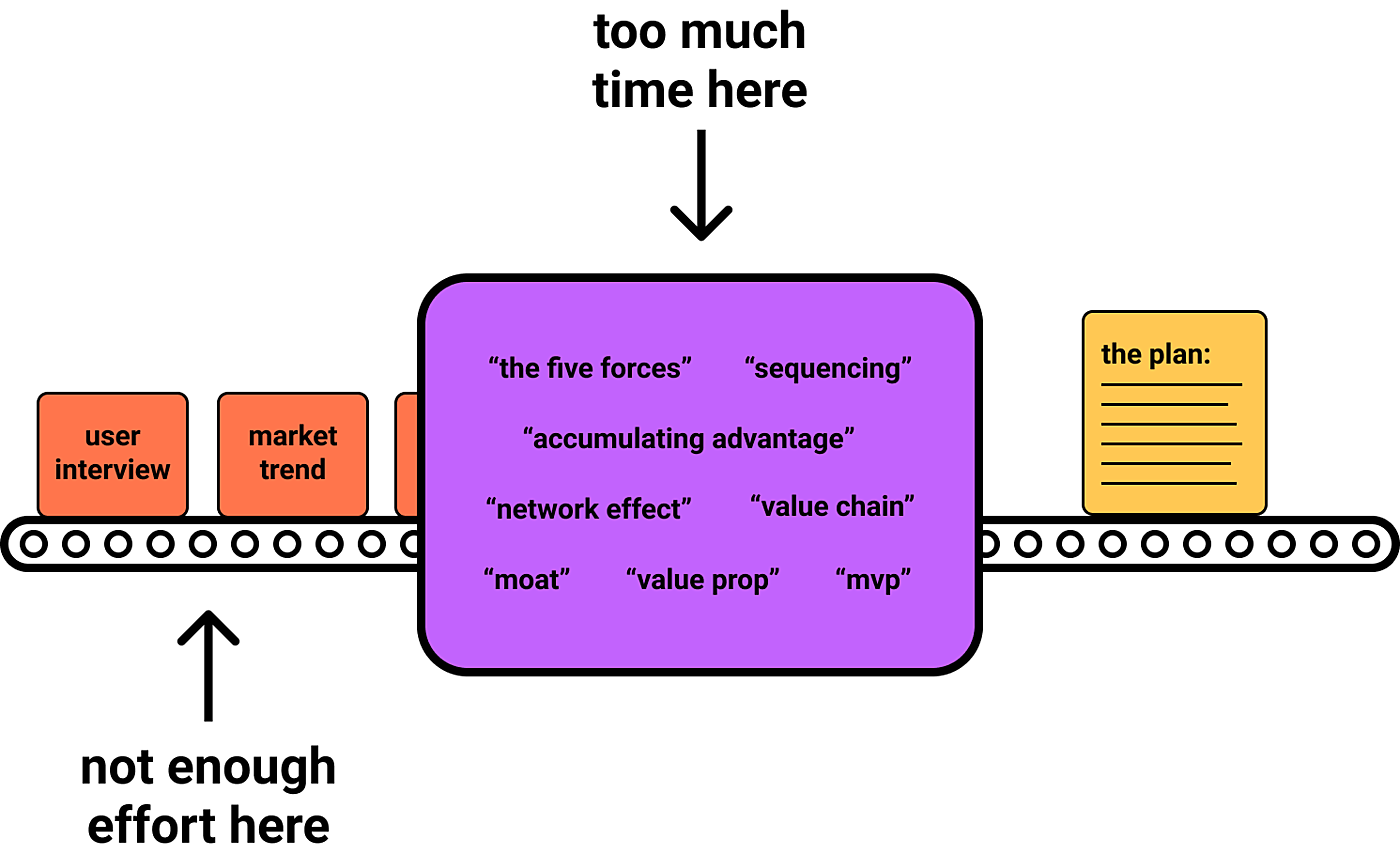
“Tech is now a mature industry.”
It’s the first thing Hiten Shah tells me when we start our interview. But he doesn’t sound depressed about it. He’s actually excited.
“It’s like spaghetti sauce. You walk down that aisle in the store and see a ton of different brands and flavors. A lot of strategy goes into it. The tech industry is basically there.”
It makes sense. It’s never been easier to build software, so there’s more competition than ever. Every category in tech now looks like a crowded grocery store aisle.
People have options.
This, says Hiten, is why strategy is more important than ever: it’s the solution to increased competition.
But how do you come up with a good strategy for your startup? Should you study business school concepts like “the five forces” or “accumulating advantages”? Or perhaps just emulate companies like Amazon and Google?
Hiten has a different idea: focus on the inputs — the facts you observe about your market and customers that get fed into strategy frameworks.
But in order to understand that, we need to zoom out and first understand Hiten’s model for how strategy formulation even works. Then, we’ll learn where most founders go wrong, and hear his tactical advice for how to improve your strategy process.
So let’s dive in :)
Hiten introduces himself
Hi! I’m Hiten Shah. Previously I started two SaaS companies: Crazy Egg and KISSmetrics. I’ve also invested / advised over 120 companies including Buffer, Clearbit, Fountain, Front, SlideShare and Webs.
My current startup is FYI. We’re building a platform that helps you find information and see what’s happening at work, starting with your documents..
I also have an email newsletter called Product Habits where my FYI co-founder and I share product development resources, our own case studies and best practices.
How Hiten creates strategies
I think of strategy formulation like a machine:
It starts with inputs — observations about the market you’re in. What are customers saying? What companies are succeeding? What trends are happening?
Then, you run those inputs through strategy frameworks that you can learn in books, in business school, or from mentors. These are ideas like “the five forces” and “moats” and “flywheels” that help you make sense of all the raw inputs.
The result you get from running inputs through your frameworks, the output of the machine, is your company strategy.
This can take the shape of something formal, like a document that outlines how your company is going to operate. But it’s also a feeling. A bet you’re excited to make, because you believe it’ll pay off.
What most founders get wrong
The most common mistake I see is to spend too much time learning the frameworks, and not enough time gathering a high quality and quantity of inputs.
That’s not to say it isn’t good to know something about strategy frameworks. They can be incredibly useful! But the inputs are where your edge is going to come from.
It’s a lot easier to read business books than to go out and talk to customers.
There’s a principle in programming called “GIGO” that explains why the inputs matter so much. It stands for “garbage in, garbage out.” Basically, it means if you feed bad data into an algorithm, it’s always going to give you back a bad result, no matter how good the algorithm is.
It works the same way with strategy: if you have a low quantity or quality of market observations, you’re not going to have a very effective strategy, no matter how many frameworks you know.
Studying human behavior
I like to study retention.
Not just of my product, but more broadly: what do people do every day? By learning what drives repetitive behavior in an industry, I can see what customers are willing to use and pay for over and over again.
For example, a designer might create new designs every day. My job is to understand why, and what problems arise every time they sit down to work. If the problem only happens every once in awhile, it’s probably not enough to build a solution for.
The most brilliant example of solving repetitive problems was Amazon’s “Simple Storage Service” (commonly known as just “S3”). It’s a way to save files on the web without worrying about what physical hard drive the file is stored on.
Their likely insight was that servers had a repeating problem: the hard drives ran out of storage space. Tons of other server issues stemmed from that core problem. So programmers would have to spend time and energy managing it, and would build all sorts of elaborate solutions they had to maintain.
It may not seem like a repetitive behavior, because it is something computers do. But those computers belong to humans, and the repetitive action the humans had to do was manage the computers. Nobody wanted to do that. So Amazon built a way for them to never think about it again.
Amazon Web Services is now a multi-billion dollar business.
The problem with document search
I’m using this process at my current company, FYI.
We spent a lot of time talking to people, and discovered that the number one problem people have with documents is finding them across all their different tools they use.
There are companies (who have since died) that tried to solve this problem with a simple search box. Why didn’t that work?
From our research, we found that people don’t necessarily remember the title or content of the document. Instead they might remember who shared it with them or what tool they created it in. So instead of a search box, we decided to design a simple interface that integrates with all their apps and helps users find documents in 3 clicks or less.
But before we go too much into FYI, let’s back up and talk about how the process for finding insights like these works.
Step 1: Gather inputs
The first step towards identifying repetitive problems is to gather as much information as I can.
I don’t look at what competitors are doing as much as what the customer is saying. I’m really digging in to learn the good, the bad, and the ugly of their experience.
When I’m gathering inputs, I’ll look just about everywhere. The App Store has reviews for some companies, and those can be really helpful. I’ll also search on Twitter for the company name plus variations of “like” or “dislike” to find what people are talking about.
You can even just look at quotes from customers on your competitors’ marketing websites. Of course they’ll be biased, but if you read between the lines, it still tells you something.
Because FYI is a B2B company, reports from Gartner or Forrester are also useful. They tend to be highly focused on Fortune 500 buys, but are good for understanding the research those buyers are consuming. We’ll sometimes search for stuff like “top challenges for managers” in Google, filter for results in the last year, and see what studies we can find. The deeper you go, the more likely you are to notice the more subtle patterns.
But my favorite form of “input” is user interviews. There’s no better way to get into the details. So I try to talk to at least a couple people every week. Usually I’ll do this by emailing them right after they sign up, but sometimes I’ll do a big batch for a special project, or even interview competitors’ customers.
(Another version of this is sales calls. Just because you’re not building an enterprise product doesn’t mean you shouldn’t do hand-to-hand sales every once in awhile!)
The best way to conduct user interviews is to ask open-ended questions. Some of them might not even seem like they relate, but the goal is to get people to tell stories.
🔮🕯 Subscriber “bonus” content goes here
(It’s Hiten’s six top questions he asks and why to uncover problems his users face with productivity tools and finding documents—607 words total.)
You’d be surprised how deep people are willing to go if you just ask and listen.
Step 2: Categorize, factualize, synthesize
Once I’ve gathered a bunch of data, I start categorizing it.
Whether it’s through commenting, labeling or tagging, the goal is to sort the data into usable chunks. I kind of turn myself into a human machine learning algorithm by trying to run as much data through my brain as possible, to grok what it all means.
The next thing I do is just write out as many facts as I can. Let’s say one of the top keywords is “price” and 73% of the reviews mention that the price is too high. That’s a fact, so I’ll write it down.
🔮🕯 Subscriber “bonus” content goes here
(It’s a screenshot from the synthesis of Hiten’s original FYI research.)
Once I have the facts written out, I synthesize the information and make connections. This is where the fun begins.
Maybe there were 73 reviews that mentioned the price is too high, but another 27 that say it’s a great price. I’ll ask myself, “what’s the connection there?” Is it something with the demographics — age, group, location? What explains the difference?
Synthesis is hard. The ideas either seem to pop into your head or they don’t.
Usually the best synthesizers are journalists or scientists, but it’s rare that this skill comes naturally to anyone. It’s hard to make non-obvious connections, and it takes time to get good at it.
Step 3: Develop a strategy
The final step is taking those insights and building them into a coherent strategy that influences your product roadmap.
The biggest customer need we found at FYI was that a lot of organizing systems get out of whack really fast. Someone always has to keep it organized and enforce the structure, otherwise it falls apart. We also learned that the single search box solutions weren’t working.
So our customer need was clear—“I want to find information but I don’t want to type in a search box”—but that in and of itself isn’t yet a strategy.
Should we focus on individuals? Businesses? A specific subset of users, like designers or writers?
We could make more money by focusing on businesses. They pay more and have lots of users. But it takes longer to convince groups of people to adopt a new product en masse than it does to convince an individual to adopt a product for themselves.
Time and feedback cycles are critical, so we decided to start with individuals in single-player mode, then work our way towards multiplayer mode.
Does it matter?
It might be tempting to skimp on your research and just try to ship things quickly. But really, you need to do both.
At FYI we have internal training for the team to do this type of work and we’ve developed our own methods to make sure we’re always on top of the inputs and running the process I described.
Far too often, I see teams focused entirely on building and not enough on learning. It might be tempting to chase growth at all costs, but the real question for a startup isn’t about who is reaching the customer faster, but rather who is solving the problem better. If you are able to do that, distribution opportunities will naturally open up.
One way I make sure to prioritize this process with my company is to relate it to what we’re focused on right now. If we have to decide on a new feature to build, we’ll use this process to figure out what it should be.
We will also do these analyses whenever there is a significant event in our market. For example, Notion got a bunch of traction recently and we did this type of customer analysis to understand why customers were so happy with this new product.
One final thought: if you focus on gathering the right customer inputs, the strategy will come to you.
Get the inputs, analyze them to inform your intuition and don’t overcomplicate the process.
You can follow Hiten on Twitter at @hnshah, and subscribe to his newsletter at ProductHabits.com.
This post was co-written with Adam Keesling. You can follow him on Twitter at @adam_keesling.
The Only Subscription
You Need to
Stay at the
Edge of AI
The essential toolkit for those shaping the future
"This might be the best value you
can get from an AI subscription."
- Jay S.
Join 100,000+ leaders, builders, and innovators

Email address
Already have an account? Sign in
What is included in a subscription?
Daily insights from AI pioneers + early access to powerful AI tools










Comments
Don't have an account? Sign up!